British Thrush Species
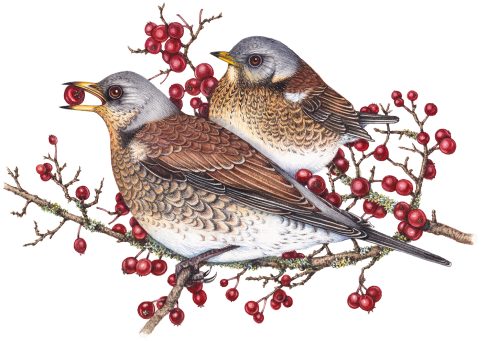
There are six species of thrush regularly seen in Britain. Some are year round residents while others overwinter here, often in large flocks. All are members of the Turdidae family of birds. Turdidae have over 60 species living on every continent on the globe except for Antarctica and Australasia. All our thrushes are a similar size (20 – 25 cm long) and are generalist feeders. They are monogamous and some mate for life.
Song thrush
The Song thrush Turdus philomelos can live in the UK year round or migrate from northern Europe. It is neatly proportioned and has a cream chest speckled with dark heart shaped marks which pale towards the belly. The back, tail, and wings are brown. tail. Uunderwings are yellowish cream, the beak is yellow and the legs are pinkish. Male and females look the same and share this warm colouration.
The fluidity of the Song thrush’s song explains its name. They start singing in January or February and sing through the summer, favouring perches a few feet from the ground. Click here to hear the song. Starting early and finishing late, they repeat phrases two to four times. The song can be heard up to half a mile away.
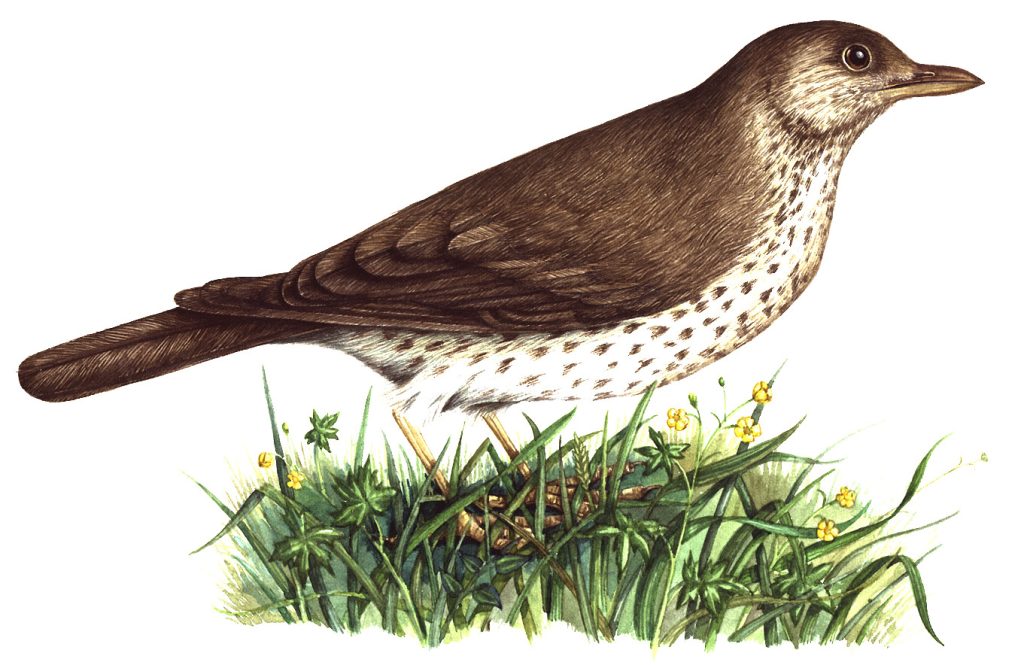
Song thrush Turdus philomelos
Another way to identify the Song thrush is from the piles of broken snail shells. Whacking the unfortunate mollusc on a favoured stone, the tap-tapping of a thrush eating snails is as much an indicator of its presence in our gardens as its song.
Originally a bird of woodland, they have adapted to life in gardens and farms. The recent increase in pesticide use that accompanies intensive agriculture is blamed for the decrease in their population, especially in farmland. They are now a red list species. The RSPB Song thrush Turdus philomelos site has a good overview of the species
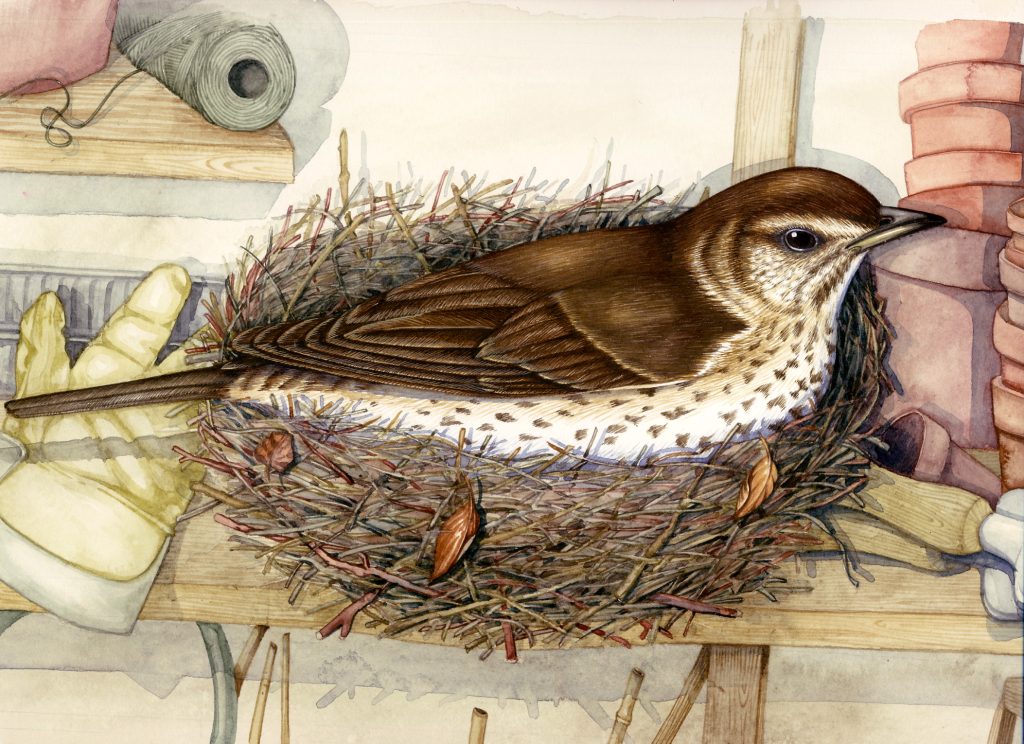
Thrush Turdus philomelos nesting in a garden shed
Mistle thrush
The Mistle thrush Turdus viscivorus is larger than the Song thrush. It tends to sit in an erect position and looks fatter and rounder than its cousin. The greyish or silvery back and head give a cooler colour scheme. It has a grey chin and may have pale cheek stripes. Like the Song thrush, it has chest speckles, but these markings are darker and are round not pointed. The Mistle thrush is less rufous and has white underwings and tail edges. It has a yellow beak and its legs are yellow not pink.
Mistle thrushes perch high up in trees to sing and often do so loudly before bad weather. This explains the colloquial name of “Stormcock”. Like the Song thrush they start singing early in the year and sing from dawn and dusk. Their song is in a minor key and sounds rather stop-start. They also have a raucous call like an old-fashioned football rattle. Click here to listen to some recordings of its song.
Visitors to gardens and parks as well as farmland, Mistle thrush have an upright bobbing way of ground foraging. They defend berry-laden trees from other birds, and can be highly territorial. Their name refers to their fondness for mistletoe berries and they are important seed dispersers for the species.
For more, visit the RSPB Mistle thrush Turdus viscivorus page.
To tell the Song and Mistle thrush apart, have a look at this BTO and Nature Guides video.
Blackbird
The Blackbird Turdus merula is a common garden visitor across the UK, except in treeless highland areas. With over 5 million pairs, the resident population is swelled in winter by visitors from northern Europe. Unlike other Thrushes, the male has no mottling on its chest but is glossy black all over, with egg-yolk yellow beak and legs. The large eyes are ringed yellow. Juveniles and females are browner and streaked with a darker shade on the chest. The beaks, legs and eye-rings of females are paler yellow.
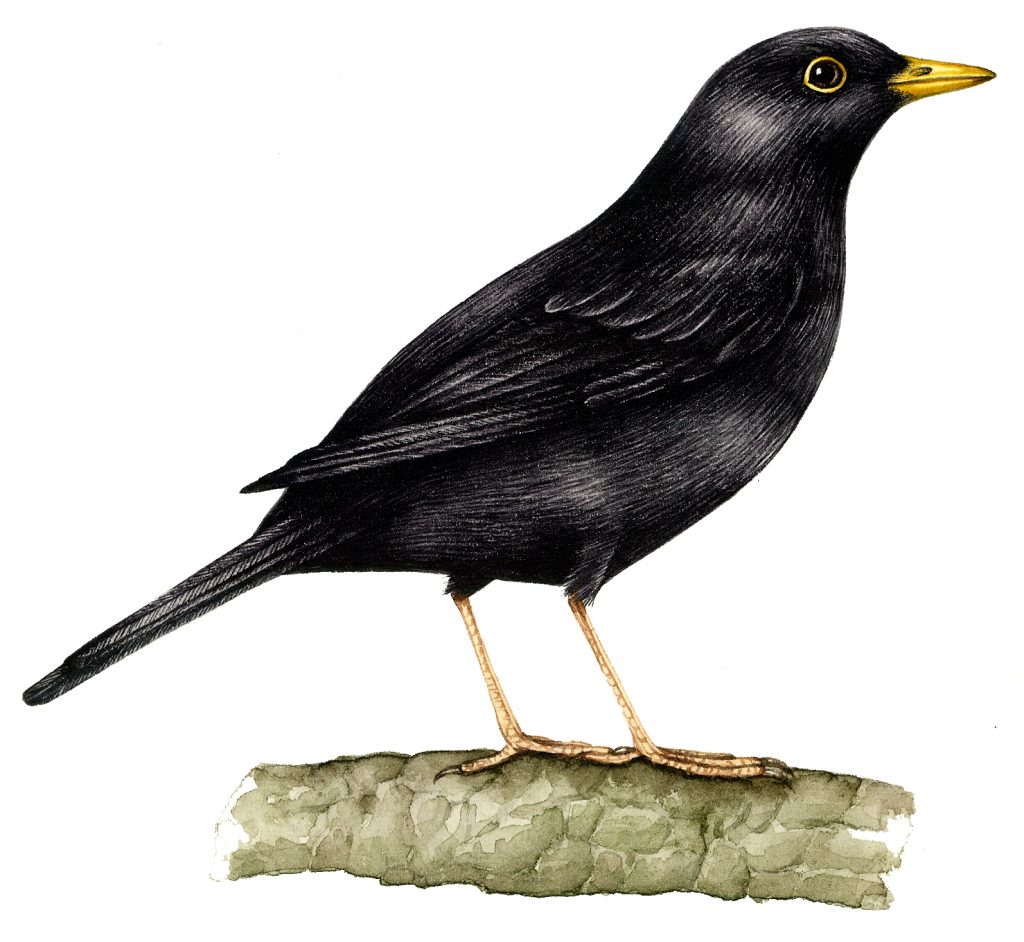
Blackbird Turdus merula
Blackbirds have a beautiful flowing song, and sing from dawn til dusk on high perches, defending their territories. The song may incorporate surrounding noises like sirens. To hear some examples of Blackbird song click here. They are monogamous and may mate for life although infidelity is common.
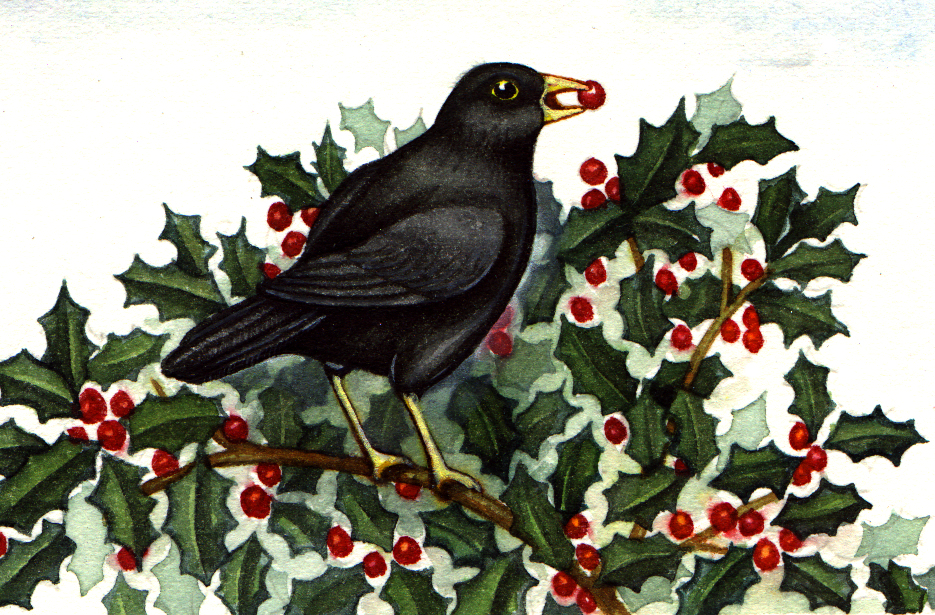
Blackbird Turdus merula eating Holly berries
Blackbirds feed at ground level, hopping along and cocking their heads to one side to listen out for worms. You can see them turning over leaves looking for beetles and woodlice. Primarily insectivores, they are also happy to eat fruit and seeds, and feed from bird tables. Although they generally live 2 to 3 years, captive birds have been known to live to 20!
For more information, take a look at the RSPB Blackbird Turdus merula site.
Fieldfare
Fieldfare Turdus pilaris are winter visitors, coming south from northern Europe. They flock, sometimes in groups up to 200 strong, and devour berries from hedgerows and trees. Sometimes the flocks are only Fieldfare but they also throng with Redwing, Mistle thrushes and Blackbirds. Fieldfare favour hawthorn, Yew and Juniper.
Larger than the Blackbird, they have blue-grey heads and black eye bands. They have black tails, grey rumps and a reddish brown back. Their bellies are pale while their yellowish chests are marked with dark brown and black. They have yellow beaks tipped with black and brown or black legs. Their chests are flushed yellow.
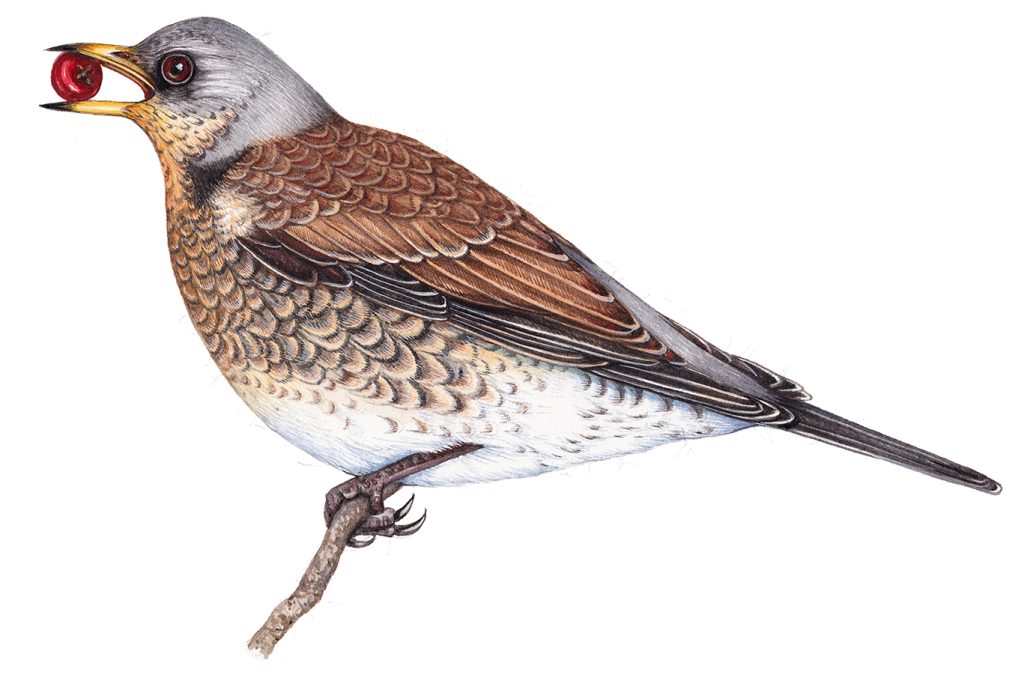
Fieldfare Turdus pilaris
Fieldfare are insectivores and can be seen hopping about on the ground with a distinctive upright stance. They also eat berries and only visit gardens in cold weather. Favoured habitats are hedgerows and open farmland, dotted with trees. Migrants arrive in October and stay until the following spring. They mate for one season, switching partners for the following year.
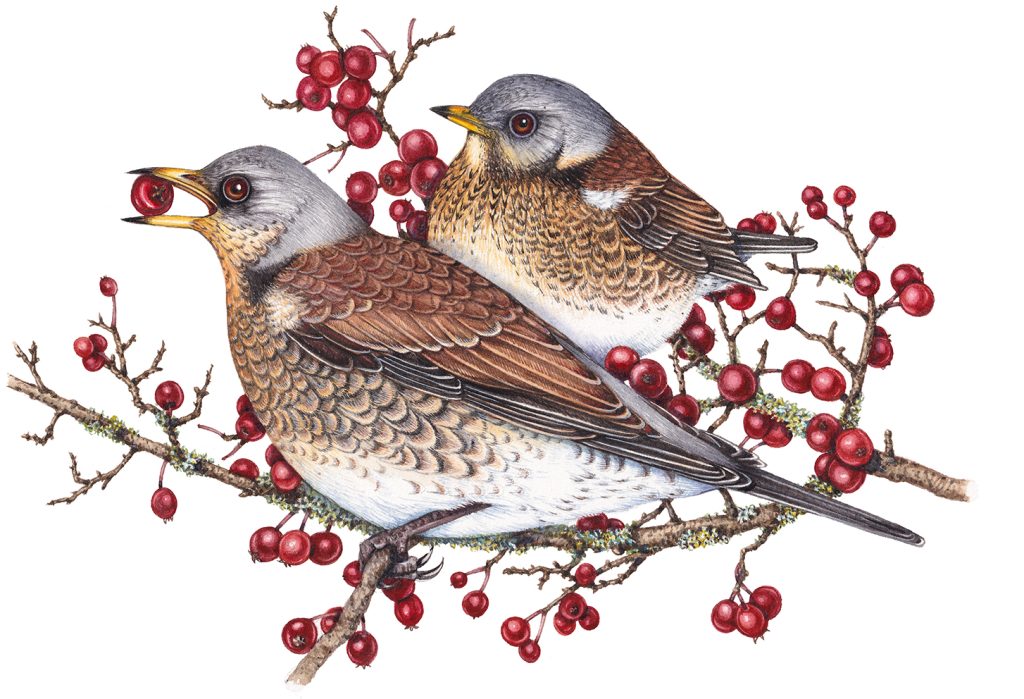
Fieldfare Turdus pilaris pair in Hawthorn
Unlike the Blackbird and Song and Mistle Thrushes, they do not have a melodious song. The males chatter with a rather rasping call. To hear Fieldfare calls click on the link.
For more on Fieldfare, visit RSPB Fieldfare Turdus pilaris
Redwing
Another winter migrant from the north, Redwing Turdus iliacus travel in flocks of up to 50 birds, during day and at night. You may hear their high pitched whirring “tzeeee” song in the dark as a group travel overhead. Click here to hear some Redwing calls.
They eat fruit and berries like the Fieldfare but are shy and harder to spot. Both species will flock together in berry-rich hedgerows, grasslands, fields of stubble, and orchards. They are unlikely to visit gardens unless conditions are very cold, when mealworms or apples might tempt them to a feeder. Although they prefer invertebrates found in the leaf litter; hawthorn, ivy and juniper berries are an important part of their diet.
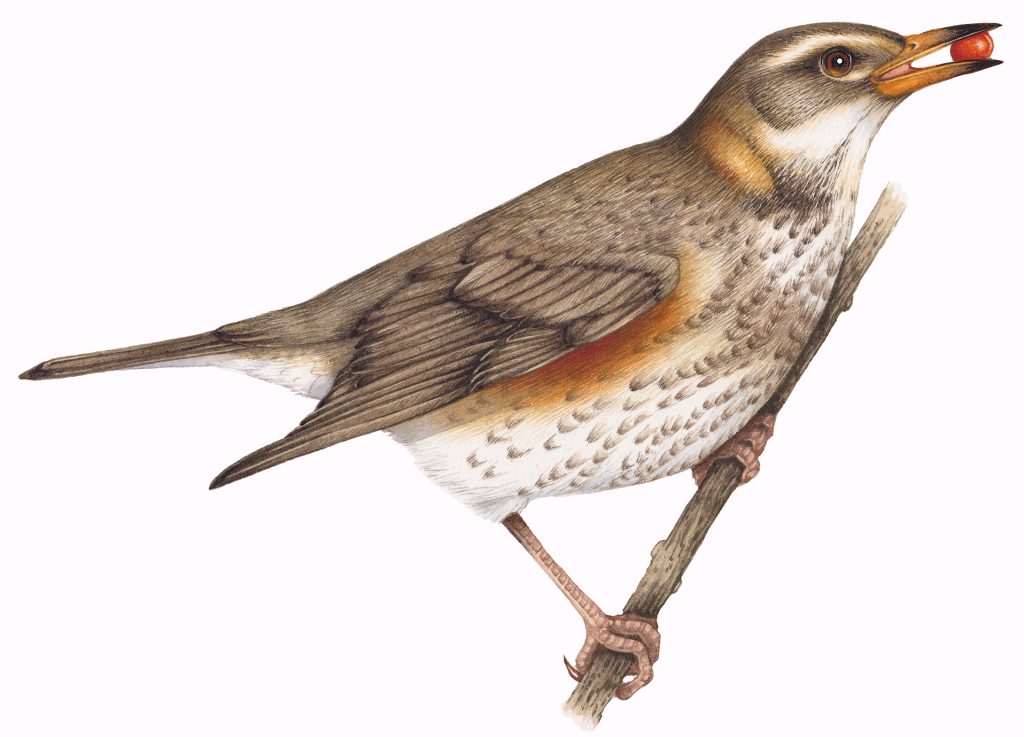
Redwing Turdus iliacus
Redwing are smaller than the other thrushes and have pale chests mottled with pale brown markings, These are shaped like downwards pointing arrows. Their backs, tails and rumps are brown, and the nape of the neck is flushed orange. They have dark eye stripes and a pale eyebrow above. Distinctive brown cheek patches, a brown moustache, a white throat and yellow beak tipped black complete the look. The most obvious colouring is the bright orange flash on the armpit and underwing, hence the name. This can be seen at rest as well as in flight. Females and males are alike but juveniles are paler and lack the orange wings and flanks. Redwing legs are a dingy pink.
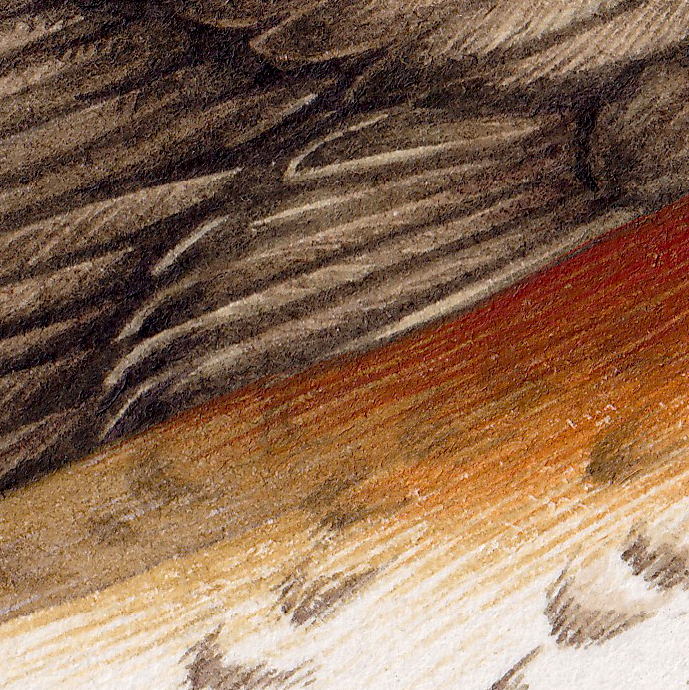
Detail of the underwing of the Redwing Turdus iliacus
A very few pairs breed in northern Scotland, most breed much further north. Monogamous during the mating season, they choose a new partner each year. They nest very close to, or on the ground.
Learn more at RSPB Redwing Turdus iliacus
Ring Ouzel
The final thrush seen regularly in the UK is the Ring ouzel Turdus torquatus. It is smaller and more slender than the blackbird and is found in northern uplands and heath. These birds overwinter in southern Europe and northern Africa and return to the UK to breed in the summer.
Ring ouzel eat worms, beetle larvae, insects and the occasional unfortunate lizard. Bilberries, cowberries, Rowan and Elderberry are also important foodstuffs, Juniper berries are so important to the bird in autumn that migration routes are set according to the abundance of these berries.
Ring ouzel have bark brownish black plumage with a distinctive white bib and neck ring. This may edge into the wings. Some of the feathers have pale edges, and although both sexes are similar the female is browner with less distinct white areas. It has a yellow beak and brown legs. Sometimes the white bib may not be obviouswhich can make it easy to confuse with the Blackbird. To tell them apart, take a look at this BTO video.
Males sing from prominent crags and outcrops to declare territory, and their song feels lonesome. It also has a harsher rattling call and a nocturnal one that can be heard when they migrate. To hear the Ring ouzel, click here.
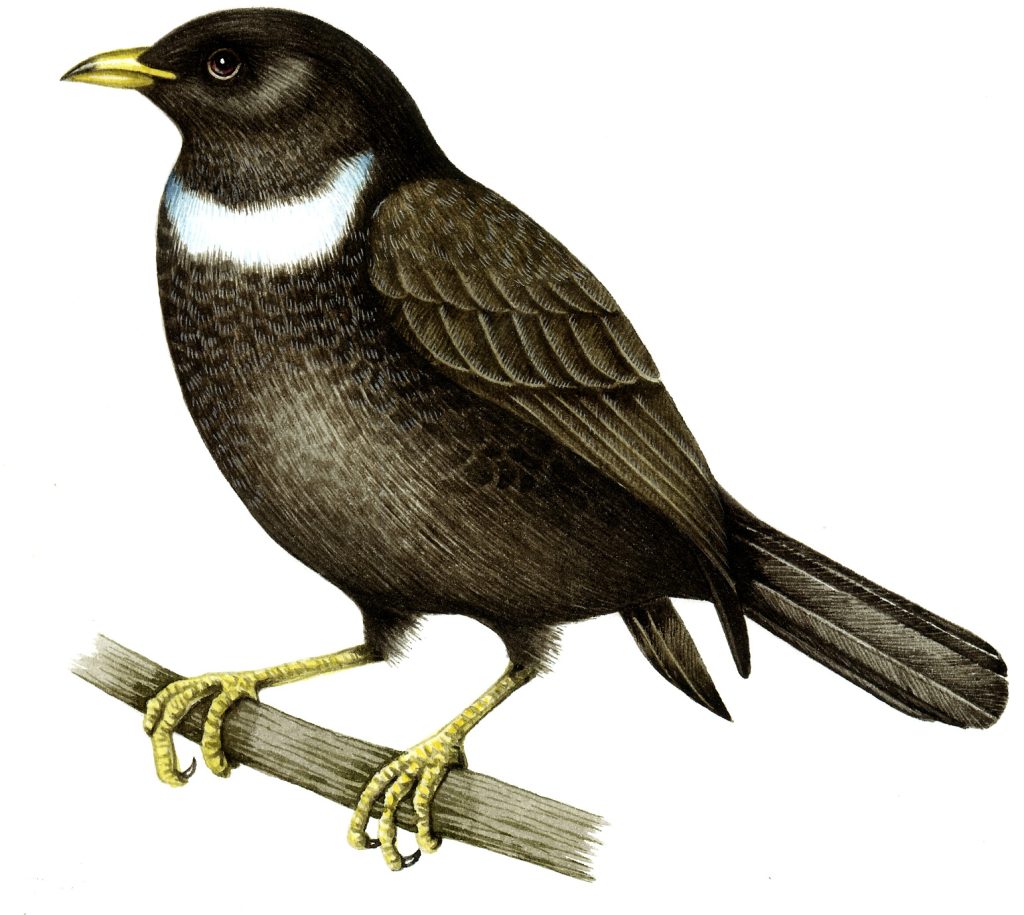
Ring ouzel Turdus torquatus
The Ring ouzel nests in ground vegetation or cracks in stones. Despite having a healthy population across much of Europe, in the UK the bird is on the conservation Red list. This is because of habitat loss leading a population drop of 60% between 1990 and 1999 (Birdfact).
For more on this species, take a look at RSPB Ring Ouzel Turdus torquatus
Conclusion
Online sources for this blog on UK thrushes include the Countryfile guide to Thrushes, Shropshire Wildlife Trust, the British Trust for Ornithology, the British Naturalist’s Association guide to thrushes, and the excellent Birdfacts guide to thrushes. For more of my bird illustrations please visit the online gallery.


I love everything you do!
That is so very kind of you. Thankyou, thankyou
merci de tout coeur Lizzie Harper, j’apprends beaucoup avec vous, vous êtes unique, votre façon de peindre aussi !!! merci pour tous les step by step !!!
Chere Brigitte
Je suis tres hereuse que vous aimez mes blogs. Merci!